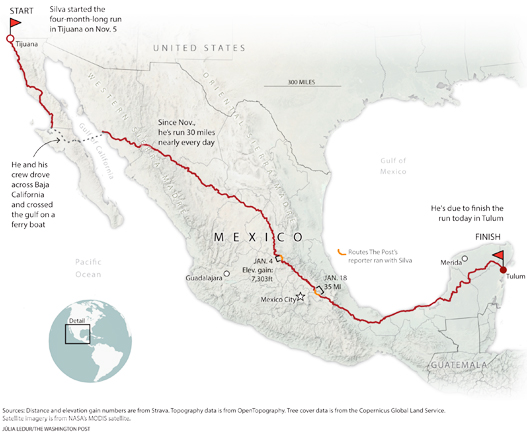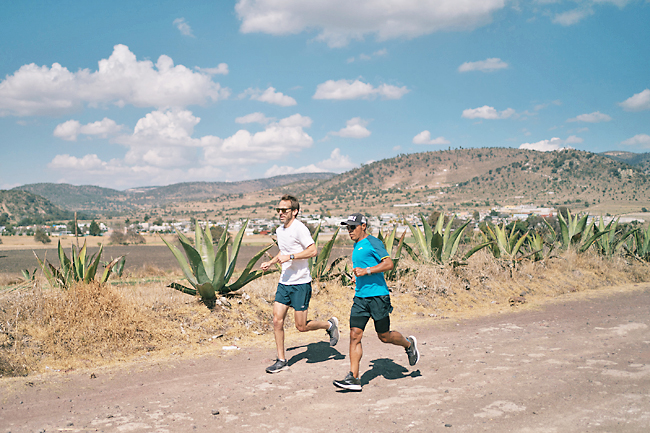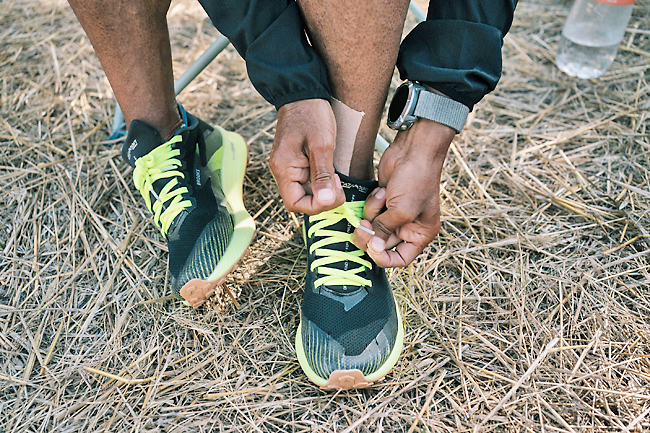Kevin Sieff
THE WASHINGTON POST – By early January, Germán Silva had run halfway across Mexico: 30 miles a day through the Sierra Madre, past befuddled cartel gunmen and bemused road crews, across vast stretches of ranch land where the cows, too, seemed to look at him askance.
There were moments when even Silva, one of the best long-distance runners in Mexico’s history, thought he might be nuts. Days when he couldn’t tell whether the greater threat to his four-month, 3,134-mile run was the terrain or his own, failing body.
He was 54. His two New York City Marathon victories were almost three decades behind him. His toenails were falling off. His left calf hurt. And his right hamstring. And basically everything else.
He was 1,574 miles into the journey, deep in the mountains of central Mexico, when I joined him last month for a day of running. Silva guessed we’d run 32 miles or so, but he wasn’t sure.
“I’m not feeling great. You’ll have to be patient with me,” he said so tenderly that I believed him.



I’ve been running most of my life. When I was nine, I had a poster from the 1994 New York City Marathon on my wall, the year Silva won it for the first time (despite making a wrong turn near the finish line). A few weeks before meeting him, I’d run my best marathon in two hours and 48 minutes. I was pretty sure I could keep up with him for a day.
We met the night before our run at a seafood restaurant 400 miles from the sea, decorated with plastic large mouth bass. I watched Silva limp up the few steps that led to the restaurant, as if he had just torn his ACL.
His body – tiny, tan and lean – seemed to disappear in his baggy sweatsuit. He looked like the human version of a swaddled gamecock.
Silva was trailed by a film crew that was documenting his journey, which he describes as traversing “the veins of Mexico”. The run, he said, is meant as a pivot away from the country’s narcos-and-beaches caricature; a nod towards something less Hollywood, less Instagrammed.
“This is Mexico!” Silva was known to exclaim spontaneously, pointing to a ripple of unnamed mountains, a stretch of desert speckled with wild agave, an abandoned hacienda whose centuries-old bell chimed in the wind.
At the peak of his career, he had used his fame to bring electricity to his rural village of Tecomate, delivering lightbulbs, fans and cold drinks to Mexico’s sweltering tropical lowlands. Now, he was trying another version of the same trick, his athleticism an arrow pointing toward his cause.
But the premise – and the documentary – was only viable if Silva could finish running. So the journey also became a study in physical endurance, and the body’s ability to recover while completing more than a marathon a day for months in a row.
At the beginning of Silva’s run, a doctor took a biopsy of his quadricep. At the end, another will be taken, so researchers can assess how the massive effort has changed his musculature.
Still, sometimes even Silva’s team – usually five or six people in two borrowed SUVs – could have a hard time parsing the rationale behind aspects of the journey. He often runs during the hottest hours of the day. He rarely checks the topography of his route. He tries to make his running shoes more comfortable by slicing holes in them with scissors. He’s gone through 18 pairs so far.
In an era of energy gels and endurance drinks, he’s consuming mostly mineral water, cacao and a traditional ground maize called pinole. He accepts dinner invitations from strangers, even when it means eating questionable seafood. He gets sick – a lot.
Instead of following a direct route through the country, Silva is running deep into rural Mexico, along dirt paths that disappear into the mountains. He logs his runs on Strava, but the global mapping software doesn’t recognise many of the unmarked trails. The mileage registers as an orange line slicing randomly through the wilderness, like the flight path of a hijacked airplane.
A few days before we met, he had run through a series of half-abandoned mining towns, leaping over cattle grates through a landscape where people had never seen anyone jog for exercise or sport. The film crew had captured him greeting locals as he ran by.
“Buenos dias,” he said enthusiastically.
They stared back at him blankly.
All the running had taken its toll. When we walked back to our hotel, I watched Silva shuffle over the cobblestones. How can a man struggling to walk, barely able to climb a flight of stairs, run another 1,500 miles, I wondered.
“There’s going to be some uphill tomorrow,” he told me.
“How much?” I asked.
“I’m not sure. But it’ll go downhill, too, at some point.”
The first few miles of the day were as perfect as any I’ve run in Mexico. The dirt road rolled over slight hills and wound through tiny villages.
There were more horses than cars. Sunlight slanted through pine trees. The only truck we saw, like an apparition, happened to be selling fresh pastries. The scent of frosting wafted over us. Every runner knows that when the running is going well, the effort seems to make a place more beautiful. Maybe it’s the endorphins. Maybe we’re just grateful to move quickly and with relative ease, and that gratitude flows from us, painting trails and roads in a flattering light.
Silva’s gait was short but efficient. The same body that struggled to walk could run with relative ease, an adaptation that in its own way proved the thesis of Silva’s project. His physiotherapist marvelled at how Silva’s body had changed, his strong legs getting stronger.
I’d been training mostly in Mexico City, a polluted megalopolis of 21 million people, where a three-mile jog sometimes felt like an outtake from Mad Max. Running with Silva on a winding trail through the Sierra Gorda was a revelation. Did anyone else know these trails existed? His project suddenly made a little more sense.
Aside from the physical challenge, looking at his route on a map, I had wondered how the logistics of the trip were possible. Mexico suffered more than 30,000 homicides last year. They took place disproportionately in a handful of states, where cartels battled for influence. Silva was running through nearly all of them – including Guanajuato, where our dreamlike run had begun.
It struck me that after years of reporting on cartel violence, I had perhaps applied the exact bias to Silva’s route that he was hoping to eviscerate. Was I overestimating the risks? In the weeks before our run, Guanajuato recorded homicides every day: at a convenience store, a fruit market, a family birthday party. Two police officers were killed; a professor of geophysics; a four-month-old in her mother’s arms.
“Have you had any trouble with security?” I asked.
“Well, we’ve run into a few armed groups,” Silva said. “There was one a few days ago.”
Oh, I thought. Not infrequently, Silva said, he has been stopped at checkpoints manned by cartel gunmen. Once, in Durango, cartel members poured into the hotel where he and his crew were staying, guns slung over their shoulders.
The Chapitos – the hotel receptionist explained casually to Silva, naming the cartel led by the sons of drug kingpin Joaquín ‘El Chapo’ Guzmán, who is now serving a life sentence in the federal supermax prison in Florence, Colorado.
But during each confrontation, Silva described his cross-country run, and the armed men let him continue on. In several cases, gunmen radioed ahead to other checkpoints, telling their comrades to expect a runner entering their territory.






